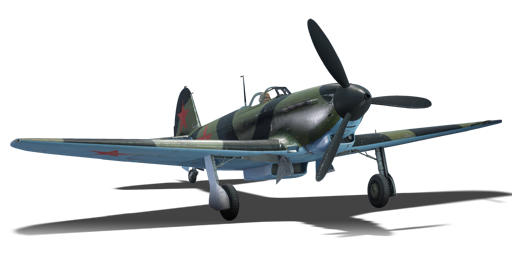



The Yakovlev Yak-9 is the first variant of the Yak-9 fighter aircraft family. Inspired by the Yak-7, the Yak-9 family remains a combination of wood and metal alloy construction. Designed around the same time as the Yak-3, the Yak-9 would prove to be the most important Soviet fighter aircraft family, seeing massive production and evolving into many variants. Alexander Sergeevich Yakovlev built the Yak-9 around a powerful set of Klimov engines that would serve as the foundation of later Yak-9 variants in the lineage. A single 20 mm ShVAK cannon with 120 rounds and a 12.7 mm Berezin UB heavy machine gun with 200 rounds were standard armaments. This weaponry combination made it a formidable opponent, capable of defeating almost anything in the skies. The visibility was excellent throughout, and the airframe proved to be sturdy and configurable to some extent. Some airframes were modified to become night fighters, long-range, and "pure" interceptors, as well as anti-tank and bomber escort variants. The combat experiences gained by Soviet pilots in the Yak-7 influenced the creation of the Yak-9. The aircraft entered service in October 1942 and were manufactured from 1942 to 1946.
Introduced in Update 1.43, the Yak-9 was the workhorse of the Soviet Air Force during World War II, and it is the standard base variant that gives rise to a huge family of variants. The Yak-9 is a well-rounded plane that is proficient in all areas. However, steep dives should still be avoided because the wings are still constructed of wood rather than metal alloy. Despite its decent turn-fighting capabilities, prolonged turning engagements or other manoeuvres will progressively drain the Yak-9's energy. Since the plane has a limited ammunition load, it is important to use trigger discipline during engagements. Given their centre alignment on the nose of the Yak-9, there is no need to adjust for gun convergence, making hitting enemies much easier for players.
flaps
flaps
flaps
brake
| Belt | Belt filling | Armor penetration (mm) at a distance: | |||||
|---|---|---|---|---|---|---|---|
| 10 m | 100 m | 500 m | 1000 m | 1500 m | 2000 m | ||
| FI-T/AP-I | 28 | 24 | 14 | 7 | 4 | 2 | |
| FI-T/HEF/AP-I/FI-T | 28 | 24 | 14 | 7 | 4 | 2 | |
| HEF/FI-T/AP-I | 28 | 24 | 14 | 7 | 4 | 2 | |
| FI-T | 3 | 3 | 3 | 3 | 3 | 3 | |
| AP-I/FI-T/AP-I/AP-I | 28 | 24 | 14 | 7 | 4 | 2 | |
| AP-I/HEF/HEF/FI | 28 | 24 | 14 | 7 | 4 | 2 | |
| Belt | Belt filling | Armor penetration (mm) at a distance: | |||||
|---|---|---|---|---|---|---|---|
| 10 m | 100 m | 500 m | 1000 m | 1500 m | 2000 m | ||
| T/AP/AP/IAI | 32 | 30 | 22 | 15 | 11 | 7 | |
| AP-I/API-T/IAI/IAI | 29 | 27 | 20 | 13 | 9 | 6 | |
| API-T/AP-I/AP-I/IAI | 29 | 27 | 20 | 13 | 9 | 6 | |
| AP-I(c)/AP-I/AP-I/API-T/IAI | 34 | 32 | 24 | 17 | 12 | 8 | |
| API-T | 29 | 27 | 20 | 13 | 9 | 6 | |
| AP-I/AP-I/IAI | 29 | 27 | 20 | 14 | 9 | 6 | |












Flight performance | |
|---|---|
Survivability |
|---|
Weaponry |
|---|